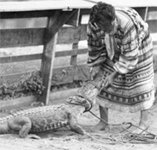Fort Smith National Historic Site [AR]
Fort Smith National Historic Site encompasses the remains of two forts, as well as the Federal Court for the Western District of Arkansas, the circa 1838 Commissary Building, and a reconstructed gallows. The original fort, Fort Smith, was in use between 1817 and 1824. The Commissary Building supplied food to troops stationed at the fort, and is currently furnished to its 1850s appearance. The visitor's center, located within the historic barracks, courthouse, and jail, contains the courtroom of Judge Parker and exhibits on the Trail of Tears, the federal court, and the military. The Cherokee, Choctaw, Chickasaw, Muscogee Creek, and Seminole walked the Trail of Tears from their ancestral homelands to Indian Territory, an area defined by the U.S. government. The fort served as training grounds for both Mexican War and Civil War soldiers. By 1872, the military compound was transformed into a courthouse and jail. It continued to function as such until 1896. Judge Isaac Parker (1838-1896) is the most famous of the judges who served at this courthouse. Known as the "Hanging Judge," during his 21 years at the fort Parker ordered the execution of 160 men. All of these convictions were for rape or murder, both of which, in the period following the Civil War, were federally required to be punished by death. Many of these cases involved acts of violence between European Americans and Native Americans. The site collections include over 225,000 artifacts.
The visitor's center offers exhibits, films, and period rooms. The Commissary Building offers period rooms. The site offers a walking trail with wayside exhibits on the Trail of Tears, Junior Ranger activities, educational programs, anniversary lectures on punishment and specific executions, in-service educator workshops, and outreach presentations. Reservations and at least two weeks notice is required for school groups. The website offers historic images, an interactive panoramic photograph, a webcam, an artifact of the month, a pre-visit PowerPoint presentation, teaching modules, lesson plans, videos for rental, photograph exhibits for rental, and word searches.
